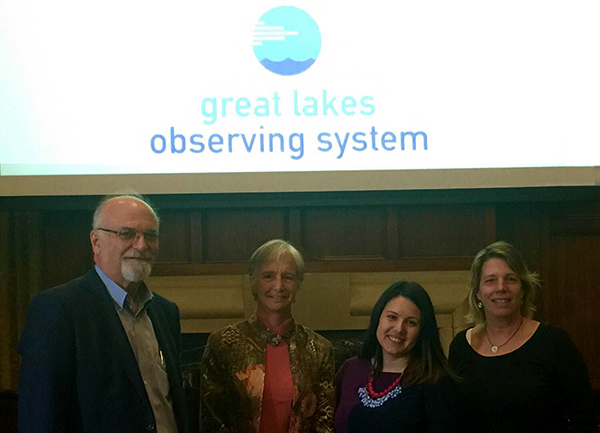
Participants at the GLOS Annual Meeting. From left: Dr. John Carey, Board Chair; Josie Quintrell, IOOS Association; Kelli Paige, GLOS Director; Zdenka Willis, IOOS Director. Photo Credit: IOOS/NOAA
The bustling campus of the University of Michigan was the backdrop for the GLOS Annual meeting. This has been a year of transition for GLOS, with Kelli Paige being promoted to Executive Director and the hiring of two new members - Andrea Maguire, who joined GLOS in April 2015 as the Program Coordinator, and Kristin Schrader joined the GLOS as the Communications Manager in March of 2015. But that has not stopped GLOS from having a banner year. They published their Great Lakes Annual Impact Report, 2015, continued to support a strong observing network, a leader in data management and submitted their certification package – only the second IOOS RA to do so.
The front page shows the new logo that GLOS unveiled at the meeting. "We had the opportunity to piggyback our own rebranding efforts on to work done by the Integrated Ocean Observing System," said Kristin Schrader, Communications Manager at GLOS. "By using complimentary colors and the research into what people feel when they think about observing, we were able to work with a talented designer to realize our role in the community through this artwork."

The new GLOS logo
I had the chance to give the IOOS State of Play briefing, which you can download here.
GLOS has set out as a major goal to lead a data sharing community. Further, the backdrop of the recent Harmful Algal Blooms causing a disruption to the drinking water dominates the discussion on observing and data needs. Finally, because in the Great Lakes the water is the drinking water and the Lakes are shared by the United States and Canada – there are complex agreements and treaties in the region that must be regarded as GLOS does their work.

Just like buoys can get fatigued exposed to the conditions in the ocean, our stakeholders can get fatigued if we reach out to them too many times. Photo Credit: IOOS/NOAA
GLOS put together 5 panels that spanned from observing needs, to data and information tools to working across the many groups in the Great Lakes. A sampling of comments from the panels:
- Tom Bridgeman, University of Toledo: HAB Blooms have gone from acceptable to catastrophic. 2003 marked the first big bloom of the modern era in Lake Erie. GLOS gets the historical data and real time data out in a useful way to managers and Charter fishing captains. It's a great partnership and takes the load off Tom. The researchers have been inundated with the recent focus, and are not staffed to support daily drinking water decisions managers need to make.
- Steve Ruberg, NOAA, GLER: Real time observations also important to the Hypoxia Warning system. Phosphorous observations critical to measure both resuspension and outflow from the river.
- Bob Shuchman, Michigan Tech Research Institute: If you have a buoy and you don’t put it on GLOS – you are nowhere! GLOS is where people go.
- Kelly Knee, Applied Science Association demonstrated MyGLOS, which will be released at the end of the year.
- Ed Verhamme, LimnoTech: GLOS sondes and Buoys allows water managers to adjust treatment of the water ahead of the toxic tests. GLOS HABs Data Viewer starting to make sense of the 13,000 data points per day a water manager needs to process.
- Tom Shyka, NERACOOS shared how they have found success: niche is real-time data; identify influential customers as force multipliers; go to customers; develop and support advocates; integrate with purpose.
GLOS is part of the Combined Federal Campaign this year! Designate 42050 to support the Great Lakes Observing System.

HABS real-time monitoring data. Photo Credit: IOOS/NOAA
 Official websites use .gov
A .gov website belongs to an official government organization in the United States.
Official websites use .gov
A .gov website belongs to an official government organization in the United States.
 Secure .gov websites use HTTPS
A lock or https:// means you’ve safely connected to the .gov website. Share sensitive information only on official, secure websites.
Secure .gov websites use HTTPS
A lock or https:// means you’ve safely connected to the .gov website. Share sensitive information only on official, secure websites.
